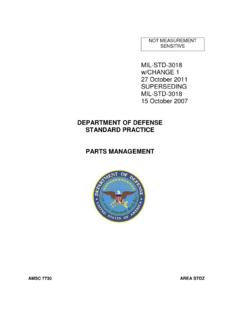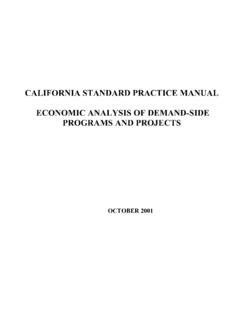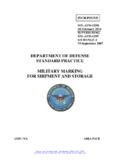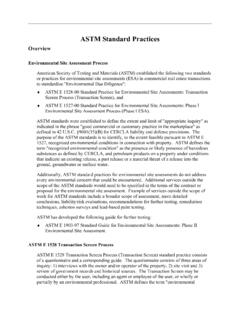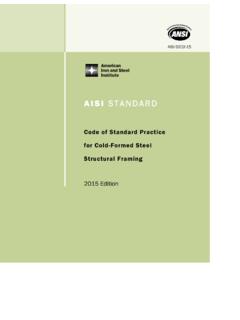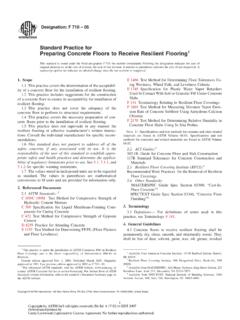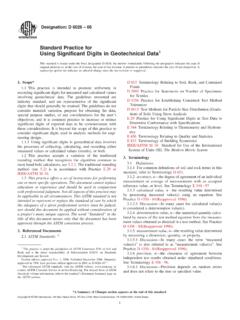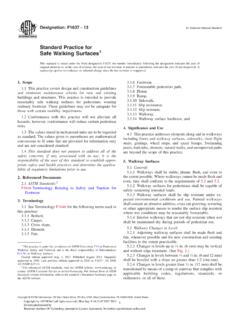Transcription of Standard Practice for Cleaning, Descaling, and Passivation ...
1 Designation: A380 06 Standard Practice forCleaning, descaling , and Passivation of stainless SteelParts, Equipment, and Systems1 This Standard is issued under the fixed designation A380; the number immediately following the designation indicates the year oforiginal adoption or, in the case of revision, the year of last revision. A number in parentheses indicates the year of last reapproval. Asuperscript epsilon ( ) indicates an editorial change since the last revision or Standard has been approved for use by agencies of the Department of Scope* This Practice covers recommendations and precautionsfor cleaning , descaling , and passivating of new stainless steelparts, assemblies, equipment, and installed systems.
2 Theserecommendations are presented as procedures for guidancewhen it is recognized that for a particular service it is desiredto remove surface contaminants that may impair the normalcorrosion resistance, or result in the later contamination of theparticular stainless steel grade, or cause product certain exceptional applications, additional requirementswhich are not covered by this Practice may be specified uponagreement between the manufacturer and the purchaser. Al-though they apply primarily to materials in the compositionranges of the austenitic, ferritic, and martensitic stainlesssteels, the practices described may also be useful for cleaningother metals if due consideration is given to corrosion andpossible metallurgical The term Passivation is commonly applied to severaldistinctly different operations or processes relating to stainlesssteels.
3 In order to avoid ambiguity in the setting of require-ments, it may be necessary for the purchaser to define preciselythe intended meaning of Passivation . Some of the variousmeanings associated with the term Passivation that are incommon usage include the Passivation is the process by which a stainless steelwill spontaneously form a chemically inactive surface whenexposed to air or other oxygen-containing environments. It wasat one time considered that an oxidizing treatment was neces-sary to establish this passive film, but it is now accepted thatthis film will form spontaneously in an oxygen-containingenvironment providing that the surface has been thoroughlycleaned or Passivation is removal of exogenous iron or ironcompounds from the surface of a stainless steel by means of achemical dissolution, most typically by a treatment with anacid solution that will remove the surface contamination butwill not significantly affect the stainlees steel itself.
4 Thisprocess is described in a general way definedprecisely further reference to the requirements ofAnnex A2and Part II of the table on acid cleaning of otherwise specified, it is this definition of passivationthat is taken as the meaning of a specified requirement Passivation is the chemical treatment of a stainlesssteel with a mild oxidant, such as a nitric acid solution, for thepurpose of enhancing the spontaneous formation of the protec-tive passive film. Such chemical treatment is generally notnecessary for the formation of the passive Passivation does not indicate the separate process ofdescaling as described in Section5, although descaling may benecessary before Passivation can be This Practice does not cover decontamination or clean-ing of equipment or systems that have been in service, nor doesit cover descaling and cleaning of materials at the mill.
5 On theother hand, some of the practices may be applicable for thesepurposes. While the Practice provides recommendations andinformation concerning the use of acids and other cleaning anddescaling agents, it cannot encompass detailed cleaning proce-dures for specific types of equipment or installations. Ittherefore in no way precludes the necessity for careful planningand judgment in the selection and implementation of These practices may be applied when free iron, oxidescale, rust, grease, oil, carbonaceous or other residual chemicalfilms, soil, particles, metal chips, dirt, or other nonvolatiledeposits might adversely affect the metallurgical or sanitarycondition or stability of a surface, the mechanical operation ofa part, component, or system, or contaminate a process degree of cleanness required on a surface depends on theapplication.
6 In some cases, no more than degreasing or removal1 This Practice is under the jurisdiction of ASTM CommitteeA01on Steel, stainless Steel and Related Alloys and is the direct responsibility of Methods of Corrosion edition approved May 1, 2006. Published May 2006. Originallyapproved in 1954. Last previous edition approved in 2005 as A380 99 (2005).DOI: *A Summary of Changes section appears at the end of this ASTM International, 100 Barr Harbor Dr. Box C700, West Conshohocken, Pennsylvania 19428-2959, United States Copyright by ASTM Int'l (all rights reserved); Thu May 10 16:20:33 EDT 2012 Downloaded/printed byBiogen pursuant to License Agreement. No further reproductions gross contamination is necessary.
7 Others, such as food-handling, pharmaceutical, aerospace, and certain nuclear ap-plications, may require extremely high levels of cleanness,including removal of all detectable residual chemical films andcontaminants that are invisible to ordinary inspection The term iron, when hereinafter referred to as a surfacecontaminant, shall denote free Attainment of surfaces that are free of iron, metallicdeposits, and other contamination depends on a combination ofproper design, fabrication methods, cleaning and Descaling, and protection to prevent recontamination of cleaned tests to establish the degree of cleanness of asurface are few, and those are often difficult to administer andto evaluate objectively.
8 Visual inspection is suitable for thedetection of gross contamination, scale, rust, and particulates,but may not reveal the presence of thin films of oil or residualchemical films. In addition, visual inspection of internalsurfaces is often impossible because of the configuration of theitem. Methods are described for the detection of free iron andtransparent chemical and oily This Practice provides definitions and describes goodpratices for cleaning , descaling , and Passivation of stainlesssteel parts, but does not provide tests with acceptance criteriato demonstrate that the Passivation procedures have beensuccessful. For such tests, it is appropriate to specify one of thepractices listed in Standard does not purport to address all of thesafety concerns, if any, associated with its use.
9 It is theresponsibility of the user of this Standard to establish appro-priate safety and health practices and determine the applica-bility of regulatory limitations prior to use.(For more specificsafety precautions , , Section8, , )2. Referenced standards :2A967 Specification for Chemical Passivation Treatmentsfor stainless Steel PartsF21 Test Method for Hydrophobic Surface Films by theAtomizer TestF22 Test Method for Hydrophobic Surface Films by theWater-Break Standard :3 Fed. Std. No. 209e for Clean Room and Work StationRequiring Controlled Environments3. Consideration should be given in the design of parts,equipment, and systems that will require cleaning to minimizethe presence of crevices, pockets, blind holes, undrainablecavities, and other areas in which dirt, cleaning solutions, orsludge might lodge or become trapped, and to provide foreffective circulation and removal of cleaning solutions.
10 Inequipment and systems that will be cleaned in place or thatcannot be immersed in the cleaning solution, it is advisable toslope lines for drainage: to provide vents at high points anddrains at low points of the item or system; to arrange forremoval or isolation of parts that might be damaged by thecleaning solution or fumes from the cleaning solutions; toprovide means for attaching temporary fill and circulationlines; and to provide for inspection of cleaned In a complex piping system it may be difficult todetermine how effective a cleaning operation has been. Onemethod of designing inspectability into the system is to providea short flanged length of pipe (that is, a spool piece) at alocation where the cleaning is likely to be least effective; thespool piece can then be removed for inspection upon comple-tion of Precleaning is the removal of grease, oil, paint, soil, grit,and other gross contamination preparatory to a fabricationprocess or final cleaning .


